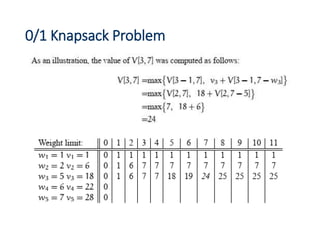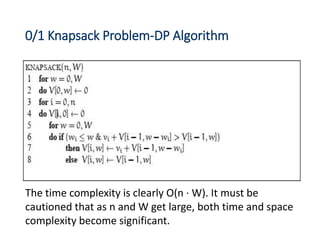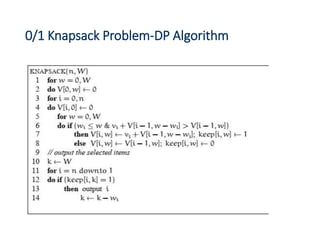Design and analysis of Algorithms - Lecture 15.ppt
- 1. Design and Analysis of Algorithms Lecture # 15 0/1 Knapsack Problem
- 2. 0/1 Knapsack Problem • A thief goes into a jewelry store to steal jewelry items. He has a knapsack (a bag) that he would like to fill up. • The bag has a limit on the total weight of the objects placed in it. If the total weight exceeds the limit, the bag would tear open. • The value of the jewelry items varies for cheap to expensive. • The thief’s goal is to put items in the bag such that the value of the items is maximized and the weight of the items does not exceed the weight limit of the bag. • Another limitation is that an item can either be put in the bag or not - fractional items are not allowed.
- 3. 0/1 Knapsack Problem • The problem is: what jewelry should the thief choose that satisfy the constraints? • Formally, the problem can be stated as follows: Given a knapsack with maximum capacity W, and a set S consisting of n items. • Each item i has some weight wi and value value vi (all wi , vi and W are integer values). • How to pack the knapsack to achieve maximum total value of packed items?
- 4. 0/1 Knapsack Problem For example, consider the following scenario:
- 5. 0/1 Knapsack Problem • The knapsack problem belongs to the domain of optimization problems. Mathematically, the problem is: • The problem is called a “0-1” problem, because each item must be entirely accepted or rejected. How do we solve the problem.
- 6. 0/1 Knapsack Problem • We could try the brute-force solution: -Since there are n items, there are 2n possible combinations of the items (an item either chosen or not). -We go through all combinations and find the one with the most total value and with total weight less or equal to W. • Clearly, the running time of such a brute-force algorithm will be O(2n). Can we do better? The answer is “yes”, with an algorithm based on dynamic programming.
- 7. 0/1 Knapsack Problem-DP Approach • For each i ≤ n and each w ≤ W, solve the knapsack problem for the first i objects when the capacity is w. • Why will this work? Because solutions to larger sub problems can be built up easily from solutions to smaller ones. We construct a matrix V [0 . . . n, 0 . . . W]. • For 1 ≤ i ≤ n, and 0 ≤ j ≤ W, V[i, j] will store the maximum value of any set of objects {1, 2, . . . , i} that can fit into a knapsack of weight j. • V[n, W] will contain the maximum value of all n objects that can fit into the entire knapsack of weight W. • To compute entries of V we will imply an inductive approach. As a basis, V[0, j] = 0 for 0 ≤ j ≤ W
- 8. 0/1 Knapsack Problem • since if we have no items then we have no value. We consider two cases: Leave object i: If we choose to not take object i, then the optimal value will come about by considering how to fill a knapsack of size j with the remaining objects {1, 2, . . . , i - 1}. This is just V[i - 1, j]. Take object i: If we take object i, then we gain a value of vi. But we use up wi of our capacity. With the remaining j - wi capacity in the knapsack, we can fill it in the best possible way with objects {1, 2, . . . , i - 1}. This is vi + V[i - 1, j - wi]. This is only possible if wi ≤ j.
- 9. 0/1 Knapsack Problem •This leads to the following recursive formulation: A naive evaluation of this recursive definition is exponential. So, as usual, we avoid re-computation by making a table . •
- 10. 0/1 Knapsack Problem • Example: The maximum weight the knapsack can hold is W is 11. There are five items to choose from. Their weights and values are presented in the following table: • The [i, j] entry here will be V[i, j], the best value obtainable using the first i rows of items if the maximum capacity were j. We begin by initializating and first row.
- 11. 0/1 Knapsack Problem • Recall that we take V[i, j] to be 0 if either i or j is ≤ 0. We then proceed to fill in top-down, left-to-right always using
- 12. 0/1 Knapsack Problem • V[i, j] = max{V[i - 1, j], vi + V[i - 1, j - wi] }
- 15. 0/1 Knapsack Problem • Finally, we have
- 16. 0/1 Knapsack Problem-DP Algorithm The time complexity is clearly O(n · W). It must be cautioned that as n and W get large, both time and space complexity become significant.
- 17. 0/1 Knapsack Problem-DP Algorithm Constructing the Optimal Solution The algorithm for computing V[i, j] does not keep record of which subset of items gives the optimal solution. To compute the actual subset, we can add an auxiliary boolean array keep[i, j] which is 1 if we decide to take the ith item and 0 otherwise. We will use all the values keep[i, j] to determine the optimal subset T of items to put in the knapsack as follows:
- 18. 0/1 Knapsack Problem-DP Algorithm
- 19. 0/1 Knapsack Problem • Here is the keep matrix for the example problem. • When the item selection algorithm is applied, the selected items are 4 and 3. This is indicated by the boxed entries in the table above.






![0/1 Knapsack Problem-DP Approach
• For each i ≤ n and each w ≤ W, solve the knapsack problem
for the first i objects when the capacity is w.
• Why will this work? Because solutions to larger sub
problems can be built up easily from solutions to smaller
ones. We construct a matrix V [0 . . . n, 0 . . . W].
• For 1 ≤ i ≤ n, and 0 ≤ j ≤ W, V[i, j] will store the maximum
value of any set of objects {1, 2, . . . , i} that can fit into a
knapsack of weight j.
• V[n, W] will contain the maximum value of all n objects
that can fit into the entire knapsack of weight W.
• To compute entries of V we will imply an inductive
approach. As a basis, V[0, j] = 0 for 0 ≤ j ≤ W](https://image.slidesharecdn.com/designandanalysisofalgorithms-lecture15-230227152007-a2d14feb/85/Design-and-analysis-of-Algorithms-Lecture-15-ppt-7-320.jpg)
![0/1 Knapsack Problem
• since if we have no items then we have no value. We
consider two cases:
Leave object i: If we choose to not take object i, then the
optimal value will come about by considering how to fill a
knapsack of size j with the remaining objects {1, 2, . . . , i -
1}. This is just V[i - 1, j].
Take object i: If we take object i, then we gain a value of vi.
But we use up wi of our capacity. With the remaining j - wi
capacity in the knapsack, we can fill it in the best possible
way with objects {1, 2, . . . , i - 1}. This is vi + V[i - 1, j - wi].
This is only possible if wi ≤ j.](https://image.slidesharecdn.com/designandanalysisofalgorithms-lecture15-230227152007-a2d14feb/85/Design-and-analysis-of-Algorithms-Lecture-15-ppt-8-320.jpg)

![0/1 Knapsack Problem
• Example: The maximum weight the knapsack can hold
is W is 11. There are five items to choose from.
Their weights and values are presented in the following
table:
• The [i, j] entry here will be V[i, j], the best value
obtainable using the first i rows of items if the
maximum capacity were j. We begin by initializating and
first row.](https://image.slidesharecdn.com/designandanalysisofalgorithms-lecture15-230227152007-a2d14feb/85/Design-and-analysis-of-Algorithms-Lecture-15-ppt-10-320.jpg)
![0/1 Knapsack Problem
• Recall that we take V[i, j] to be 0 if either i or j is ≤ 0. We
then proceed to fill in top-down, left-to-right
always using](https://image.slidesharecdn.com/designandanalysisofalgorithms-lecture15-230227152007-a2d14feb/85/Design-and-analysis-of-Algorithms-Lecture-15-ppt-11-320.jpg)
![0/1 Knapsack Problem
• V[i, j] = max{V[i - 1, j], vi + V[i - 1, j - wi] }](https://image.slidesharecdn.com/designandanalysisofalgorithms-lecture15-230227152007-a2d14feb/85/Design-and-analysis-of-Algorithms-Lecture-15-ppt-12-320.jpg)




![0/1 Knapsack Problem-DP Algorithm
Constructing the Optimal Solution
The algorithm for computing V[i, j] does not keep record
of which subset of items gives the optimal solution. To
compute the actual subset, we can add an auxiliary
boolean array keep[i, j] which is 1 if we decide to take the
ith item and 0 otherwise. We will use all the values keep[i,
j] to determine the optimal subset T of items to put in
the knapsack as follows:](https://image.slidesharecdn.com/designandanalysisofalgorithms-lecture15-230227152007-a2d14feb/85/Design-and-analysis-of-Algorithms-Lecture-15-ppt-17-320.jpg)

